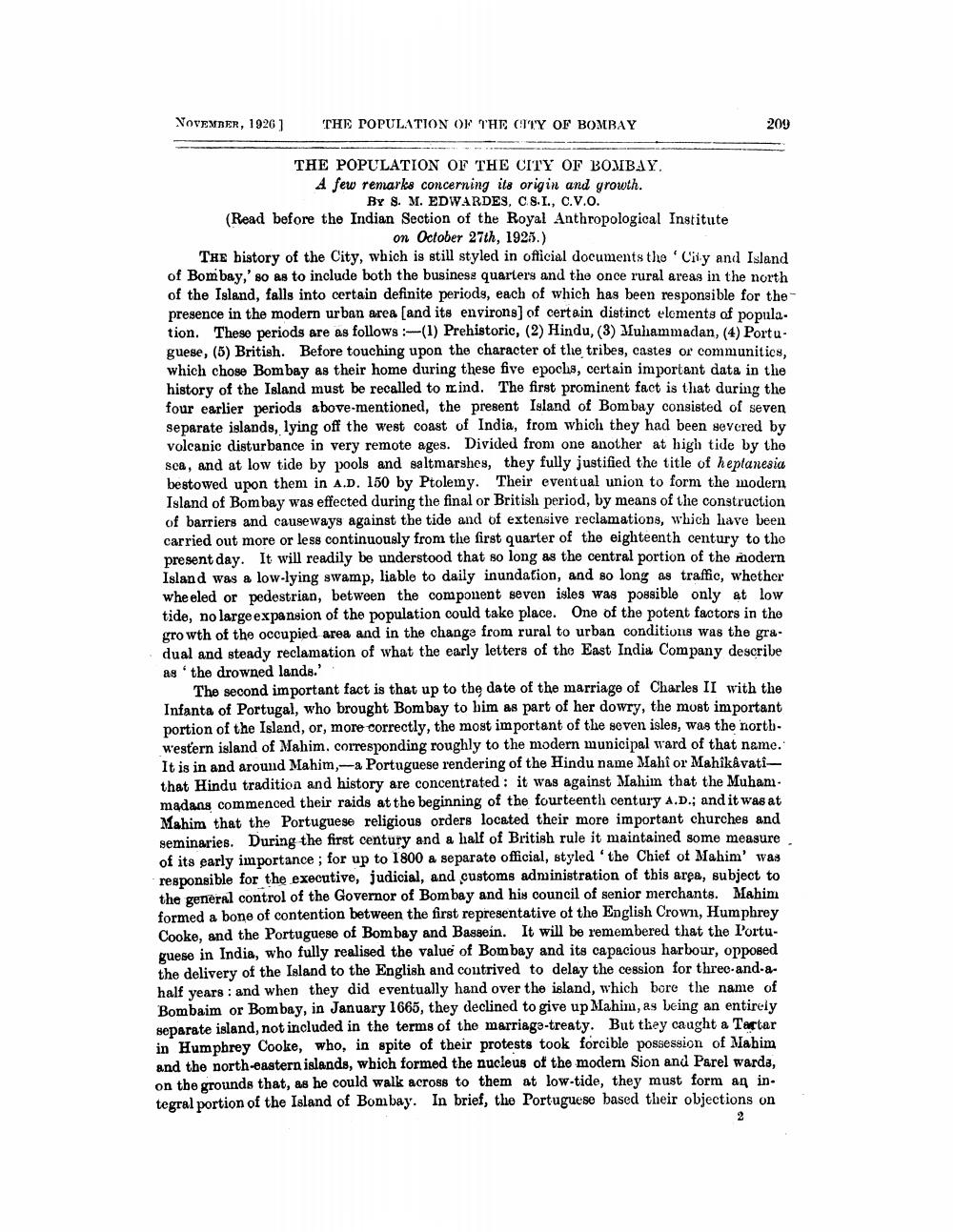________________
NOVEMNER, 1926)
THE POPULATION OF THE CITY OF BOMBAY
209
THE POPULATION OF THE CITY OF BOMBAY A few remarks concerning its origin and growth.
BY S. M. EDWARDES, C.S.I., C.V.O. (Read before the Indian Section of the Royal Anthropological Institute
on October 27th, 1925.) The history of the City, which is still styled in official documents the City and Island of Bombay, so as to include both the business quarters and the once rural areas in the north of the Island, falls into certain definite periods, each of which has been responsible for the presence in the modern urban area (and its environs) of certain distinct eloments of popula. tion. These periods are as follows (1) Prehistoric, (2) Hindu, (3) Muhammadan, (4) Portuguese, (5) British. Before touching upon the character of the tribes, castes or communitics, which chose Bombay as their home during these five epochis, certain important data in the history of the Island must be recalled to vind. The first prominent fact is that during the four earlier periods above-mentioned, the present Island of Bombay consisted of seven Separate islands, lying off the west coast of India, from which they had been severed by volcanic disturbance in very remote ages. Divided from one another at high tide by the sca, and at low tide by pools and saltmarshes, they fully justified the title of heptanesia bestowed upon them in A.D. 150 by Ptolemy. Their eventual union to form the modern Island of Bombay was effected during the final or British period, by means of the construction of barriers and causeways against the tide and of extensive reclamations, which have been carried out more or less continuously from the first quarter of the eighteenth century to the present day. It will readily be understood that so long as the central portion of the modern Island was a low-lying swamp, liable to daily inundation, and so long as traffic, whether wheeled or pedestrian, between the component seven isles was possible only at low tide, no large expansion of the population could take place. One of the potent factors in the growth of the occupied area and in the change from rural to urban conditions was the gradual and steady reclamation of what the early letters of the East India Company describe as the drowned lands.'
The second important fact is that up to the date of the marriage of Charles II with the Infanta of Portugal, who brought Bombay to him as part of her dowry, the most important portion of the Island, or, more correctly, the most important of the seven isles, was the northwestern island of Mahim. corresponding roughly to the modern municipal ward of that name. It is in and around Mahim,-a Portuguese rendering of the Hindu name Mahi or Mahikâvatithat Hindu tradition and history are concentrated : it was against Mahim that the Muhammadans commenced their raids at the beginning of the fourteenth century A.D.; and it was at Mahim that the Portuguese religious orders located their more important churches and seminaries. During the first century and a half of British rule it maintained some measure of its early importance ; for up to 1800 a separate official, styled 'the Chief of Mahim' was responsible for the executive, judicial, and customs administration of this area, subject to the general control of the Governor of Bombay and his council of senior merchants. Mahim formed a bone of contention between the first representative of the English Crown, Humphrey Cooke, and the Portuguese of Bombay and Bassein. It will be remembered that the l'ortuguese in India, who fully realised the value of Bombay and its capacious harbour, opposed the delivery of the Island to the English and contrived to delay the cession for three-and-ahalf years : and when they did eventually hand over the island, which bore the name of Bombaim or Bombay, in January 1665, they declined to give up Mahim, as being an entirely separate island, not included in the terms of the marriaga-treaty. But they caught a Tartar in Humphrey Cooke, who, in spite of their protests took forcible possession of Mahim and the north-eastern islands, which formed the nucleus of the modern Sion and Parel warda, on the grounds that, as he could walk across to them at low-tide, they must form an in. tegral portion of the Island of Bombay. In brief, the Portuguese based their objections on




